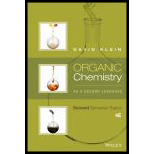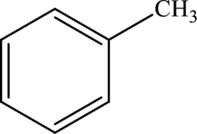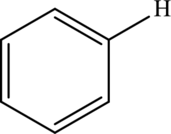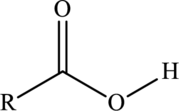
Concept explainers
Interpretation:
The structure for a compound with molecular formula
Concept Introduction:
Determination of structure of a compound from its proton NMR spectrum:
There are several steps to be followed for the determination of the structure as given below.
Step
Calculation of hydrogen deficiency index (HDI) from the molecular formula.
It can be formulated as given below.
Where,
If
If
If
Step
Consider the number of signals and integration of each signal. This gives the clues about the symmetry of the compound.
In order to convert the integration values into useful information, a smallest number should be chosen and then all integration values should be divided by this number. If the numerical values are not whole numbers, then in order to arrive at whole numbers all the numbers should be multiplied by a suitable integer.
Step
Analyze each signal and then draw fragments consistent with each signal. Consider chemical sift value, integration and multiplicity. If
Step
Assemble the fragments into a molecular structure.
Important chemical shift values and splitting patterns:
An ethyl group is characterized by a triplet of
| Type of proton | Chemical shift |
| Methyl group | |
| Methylene group | |
| Methine group | |
Allylic  | |
Alkynyl  | |
Aromatic methyl  | |
Alkyl halide  | |
Alcohol  | |
Vinylic  | |
Aryl  | |
Aldehyde  | |
Carboxylic acid  |
Key point:
Methyl protons, methylene protons and methine protons attached to a carbonyl group give a chemical shift value of
Want to see the full answer?
Check out a sample textbook solution
Chapter 3 Solutions
Organic Chemistry As a Second Language: Second Semester Topics
- You are provided an unknown sample with the molecular formula C8H9NOName and draw the structure of the compound based from the NMR specarrow_forwardPropose a structure for the compound with the formula C5H11Cl that would produce the following C13 NMR spectrum.arrow_forwardPlease look at the Proton NMR spectrum and identify the proposed molecular structure. There is also a signal at 9.769 ppm indicating that an aldehyde is presentarrow_forward
- What is the molecular formula structure and its proton environment of these two spectrum?arrow_forwardYou are provided an unknown sample with the molecular formula C8H9NO. After running the NMR, you obtain the following spectra. Name and draw the structure of the compoundarrow_forwardAn NMR spectrum was run for the following compound. Assign proton NMR peaks and explain.arrow_forward
- Are there any non-aromatic or non-alkene protons seen in the 1H NMR Spectrum (yes or no)? If so, please list the corresponding ppm values.arrow_forwardPredict the appearance of NMR spectrum of propyl bromidearrow_forwardDraw the structure with formula C5H12O2 that fits the following NMR spectrumarrow_forward
- (a) Base on the information provided, determine the structures of compounds. (b) Assign all peaks in 1 H and 13C NMR spectra of compoundsarrow_forwardDetermine the structure of a compound with the formula C11H15ClO2 based on the 1H NMR spectrum below. Based on its 13C NMR (DEPT) spectrum, it is evident that this molecule shows 9 signals including one methyl (CH3) and four methylene (CH2) units.arrow_forwardAnalyse the high resolution proton NMR spectrum and suggest a compound and write its name. Also write down which parts of the molecule belongs to each peak.arrow_forward
 Organic Chemistry: A Guided InquiryChemistryISBN:9780618974122Author:Andrei StraumanisPublisher:Cengage Learning
Organic Chemistry: A Guided InquiryChemistryISBN:9780618974122Author:Andrei StraumanisPublisher:Cengage Learning EBK A SMALL SCALE APPROACH TO ORGANIC LChemistryISBN:9781305446021Author:LampmanPublisher:CENGAGE LEARNING - CONSIGNMENT
EBK A SMALL SCALE APPROACH TO ORGANIC LChemistryISBN:9781305446021Author:LampmanPublisher:CENGAGE LEARNING - CONSIGNMENT

